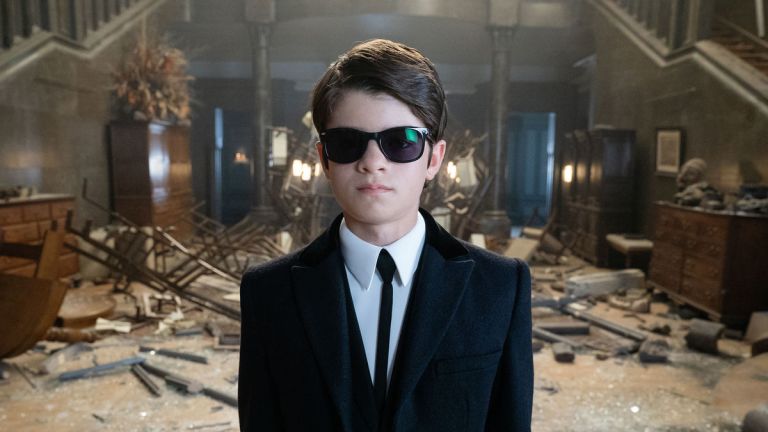Will the Artemis Fowl Movie Change Its Protagonist From Antihero to Hero?
Softening the edges on child anti-hero Artemis Fowl would be a mistake.

The Artemis Fowl movie was supposed to hit theaters at the end of May. But with the COVID-19 pandemic continuing to impact movie theaters, Disney has decided to premiere the film on their Disney+ streaming service. Since the first trailers came out, reaction from fans has been mixed. (Some have expressed their dismay by saying that now they understand how Percy Jackson fans felt about their film adaptation—something Disney+ hopes to remedy with their upcoming Percy Jackson series.)
The reason fans are so torn by the trailer is that the Artemis Fowl (Ferdia Shaw) introduced is a fresh-faced, naive child who discovers the fairy world after his father, a “collector” of stolen artifacts, goes missing. He gets an explanation from his bodyguard Butler (Nonso Anozie) that his father was actually part of a group trying to keep dangerous magical artifacts from harming mankind.
Young film Artemis now has to step into his father’s shoes, recover a magical artifact, and save his father in order to save the world. His team? Holly Short (Lara McDonnell), a fairy, and Mulch Diggums (Josh Gad), a giant dwarf. Alongside Butler, the four of them will set out on a mission to save the human world and fairy worlds from an insidious fairy foe.
Thus the film sets up Artemis as a Harry Potter-esque figure. One early critic compared Artemis’ wide-eyed awe to Harry Potter’s reaction to the Wizarding World in Harry Potter and the Sorcerer’s Stone, with Mulch Diggums as a mini Hagrid, and even the appearance of Judi Dench’s Commander Root being similar to Maggie Smith’s McGonnagall. In the trailer, Artemis’ first moment looking at the fairy world shows him full of wonder and astonishment. When Holly Short warns him that trolls eat people, he gives a very convincing gulp before saying, “Good to know.” He’s emotional in the way that kids will connect with—he might be a genius, and the next criminal mastermind, but he’s also a kid, and their viewpoint character into the fairy world.
All of which is not the Artemis Fowl that fans grew up with.
The original novel Artemis Fowl by Eoin Colfer, published in 2001, introduced a calculating boy who bribed and threatened his way into stealing The Book of the People, a book that will give him all of the secrets of fairies so that he can exploit them. He’s mainly interested in fairy gold: his father’s disappearance (as in the film) has lost his family much of their wealth, and while he remains a millionaire, he’s determined to bring the family back to their former glory. (His mother’s mental and physical illness allow him to maneuver without adult interference; Butler, his bodyguard, rarely serves as his conscience, and instead acts as his employee.)
Once he’s nabbed The Book, he uses it to kidnap a fairy: in this case, LEP Recon (yes, pronounced leprechaun) officer Holly Short. Once he has Holly in his clutches, he makes plans to ransom her to the LEP. If he can successfully outwit the fairies, he’ll be able to keep whatever gold they bring in ransom. This doesn’t sit well with Holly’s fellow LEP officers. Commander Root (her boss), Foaly (a centaur who is the fairy world’s version of Q from the James Bond franchise), and even dwarf criminal Mulch Diggums get in on the bid to retrieve Holly without losing the gold to Artemis. There’s a bit of trouble in the middle with a troll, and by the end of the novel Holly has developed a sense of responsibility for Butler, Butler’s teenaged sister Juliet (who was also complicit in Holly’s kidnapping), and even Artemis.
Of course Artemis wins in the end, though not without a bit of remorse—it turns out neither he nor Butler had expected fairies to be so human.
In the sequel, Artemis Fowl and the Arctic Incident, which Disney and Branagh combined with the original for the purposes of the film, Artemis and Holly do team up to stop a goblin rebellion and an evil genius pixie determined to rule the world. A glance at the trailer shows that this provides much more of the basis for the film’s plot: not only do Artemis and Holly become allies, but the story also revolves around rescuing Artemis’ criminal mastermind father.
Why the change from antihero (or outright villain, as some fans claim) to hero? One of the things that’s striking about Artemis Fowl (the novel) is the high proportion of amoral characters among the cast, which is especially rare for a series aimed at kids. Artemis—a cool, calculating criminal who scolds himself for even thinking a joke—shows very little hesitation at throwing his resources around to get exactly what he wants, no matter who is in the way. He feels a twinge of guilt at lying to Holly in what amounts to mental torture, but he proceeds nonetheless, because his goal—wealth—is too important to sacrifice. Root and Foaly show little evidence of their own moral high ground throughout the book; Root mulls over citizens who complain about the police using unreasonable force (which strikes a queasy note when reading the novel in 2020) and has no compunctions about killing Artemis, Butler, and Juliet if that’s what it takes to complete their mission.
Butler has moments—Artemis recognizes that deceit is hard for his honorable bodyguard—but he ultimately falls in line with his boss’ wishes. Only Holly, who risks her life and her job to save humans from a rampaging troll, and who pleads for mercy for the humans who captured her, consistently acts in the style of a fantasy hero. She’s presented as a foil for Artemis, his opposite, and as the series progresses, she becomes the expert on Artemis as a threat to the fairy world.
It’s clear that Eoin Colfer expected his middle grade readers to be up to the challenge of handling that amorality. He doesn’t talk down to his audience and he expects kids to keep up with the story. That high expectation and understanding of his readers led the series to be a huge hit that spanned eight books. But whether or not that type of amorality would go over well in a film setting is up for debate. Fantasy films and series aimed at a younger audience tend to have identifiable heroes from the get go. If a hero moves from villain to hero (think Zuko in Avatar: The Last Airbender or Agent Kallus in Star Wars: Rebels), they have a full story arc to get them there, and they aren’t the central protagonist of the series. It could be that the filmmakers didn’t want to hold a viewing audience to Colfer’s high expectations, which would be a mistake. Trusting the story literacy of young readers, including a desire for moral messiness in middle grade protagonists, is the solid foundation on which the Artemis Fowl book universe was built.
The motivations behind the changes are, as yet, unknown. Perhaps Disney wanted to rely on a more tried-and-true formula, giving viewers the same style of story they’ve come to expect. Maybe some premonition led the writers and adapters to the conclusion that 2020 was going to need more light-hearted escapist fiction than amoral antihero tales. Thus far Eoin Colfer has sounded quite pleased with the adaptation, so perhaps there’s more going on in the film than the trailers show.
But until the release, we’ll just have to make our best guesses about whether naive film Artemis can live up to the brilliance and calculation of his book predecessor.
